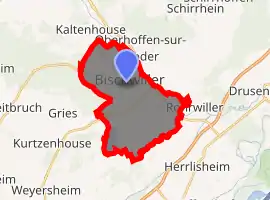Bischwiller
Bischwiller (German: Bischweiler; Alsatian: Bìschwiller) is a commune in the Bas-Rhin department in Grand Est in northeastern France just west of the Moder River.[lower-alpha 1]
Bischwiller
Bìschweiler | |
|---|---|
 La Laub, former town hall, now a museum | |
 Coat of arms | |
Location of Bischwiller 
| |
 Bischwiller  Bischwiller | |
| Coordinates: 48°46′00″N 7°51′27″E | |
| Country | France |
| Region | Grand Est |
| Department | Bas-Rhin |
| Arrondissement | Haguenau-Wissembourg |
| Canton | Bischwiller |
| Government | |
| • Mayor (2014–2020) | Jean-Lucien Netzer |
| Area 1 | 17.25 km2 (6.66 sq mi) |
| Population | 12,538 |
| • Density | 730/km2 (1,900/sq mi) |
| Time zone | UTC+01:00 (CET) |
| • Summer (DST) | UTC+02:00 (CEST) |
| INSEE/Postal code | 67046 /67240 |
| Elevation | 123–147 m (404–482 ft) |
| 1 French Land Register data, which excludes lakes, ponds, glaciers > 1 km2 (0.386 sq mi or 247 acres) and river estuaries. | |
Geography
The city is 7.8 kilometers (4.8 mi) southeast of Haguenau, 8 kilometers (5.0 mi) west-northwest from the German border and the Rhine River (Rhin), and lies 22 kilometers (14 mi) north-northeast of Strasbourg.
The Moder river, a Rhine tributary, flows across the town. Among the other streams which cross the area can be cited the following tributaries of the Morder: the Rothbaechel, the Erlengraben and the Waschgraben. The last one is formed by the confluence of two smaller streams named Weihergraben and Schnuchgraben.
Population
Due to its large Turkish minority, Bischwiller is often dubbed "Turkwiller".[3]
| Year | Pop. | ±% |
|---|---|---|
| 1793 | 3,250 | — |
| 1800 | 3,449 | +6.1% |
| 1806 | 3,902 | +13.1% |
| 1821 | 4,806 | +23.2% |
| 1831 | 5,927 | +23.3% |
| 1836 | 5,854 | −1.2% |
| 1841 | 5,721 | −2.3% |
| 1846 | 6,260 | +9.4% |
| 1851 | 6,642 | +6.1% |
| 1856 | 7,676 | +15.6% |
| 1861 | 8,780 | +14.4% |
| 1866 | 9,911 | +12.9% |
| 1869 | 11,500 | +16.0% |
| 1871 | 9,220 | −19.8% |
| 1875 | 7,102 | −23.0% |
| 1880 | 6,827 | −3.9% |
| 1885 | 6,815 | −0.2% |
| 1890 | 7,014 | +2.9% |
| 1895 | 7,304 | +4.1% |
| 1900 | 7,897 | +8.1% |
| 1905 | 8,279 | +4.8% |
| 1910 | 8,149 | −1.6% |
| 1921 | 7,210 | −11.5% |
| 1926 | 8,142 | +12.9% |
| 1931 | 8,059 | −1.0% |
| 1936 | 8,248 | +2.3% |
| 1946 | 7,581 | −8.1% |
| 1954 | 7,843 | +3.5% |
| 1962 | 8,198 | +4.5% |
| 1968 | 8,780 | +7.1% |
| 1975 | 9,653 | +9.9% |
| 1982 | 10,612 | +9.9% |
| 1990 | 10,969 | +3.4% |
| 1999 | 11,596 | +5.7% |
| 2006 | 12,830 | +10.6% |
| 2009 | 12,646 | −1.4% |
Personalities
- Henri Baumer, master carpenter
- Claude Vigée, poet
- Jacob Kirkman and Abraham Kirkman, harpsichord makers
- Jean Daum, glassware manufacturer
- Lucien Muller, footballer
- Otto Meißner, German politician
- Christian Goodnight (born Christian Gutknecht) is a direct-line ancestor of former U.S. President Barack Obama.[4][5][6][7]
Photo gallery
 Ancient timber-framed pharmacy
Ancient timber-framed pharmacy Saint-Augustin church
Saint-Augustin church Bischwiller town hall
Bischwiller town hall Protestant temple: tombstone of John I, Count Palatine of Zweibrücken (died in 1604) tombstone
Protestant temple: tombstone of John I, Count Palatine of Zweibrücken (died in 1604) tombstone
See also
Notes
- Also spelt Bishweiller in some older sources.[2]
- "Populations légales 2017". INSEE. Retrieved 6 January 2020.
- Rapp 1823, pp. 365–366.
- Le Point. "Alsace le ghetto turc". Archived from the original on 2014-12-14. Retrieved 2014-12-14.
- Forek, Scott (September 9, 2007). "Christian Gutnecht-Goodnight: 'The dark and bloody ground'". Chicago Sun-Times. Archived from the original on March 4, 2009. Retrieved March 20, 2009.
- Neue Zürcher Zeitung 24 juillet 2008, Die Zeit of the same day, and Zeitmagazin Leben 24.7.2008, N.31, p.14-15 (the article in the Zeitmagazin contains a complete genealogy of Barack Obama)
- "Obama's forefathers include Swiss immigrant: archivist". Agence France-Presse. September 24, 2008.
- Harneis, Robert (January 20, 2009). "Goodnight Mr. President". French News. Archived from the original on January 31, 2009. Retrieved March 20, 2009.
References
- INSEE commune file
- Rapp, comte Jean (1823), Memoirs of General Count Rapp: First Aide-de-camp to Napoleon, H. Colburn and Company
